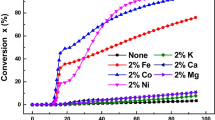Abstract
The present as well as future shortages of petroleum derived hydrocarbons for use as starting materials for the synthesis of various organic chemicals and products have stimulated search in the use of Coal/Lignite as raw materials for chemicals production. Coal can be exploited to produce carbocyclic derivatives for a wide spectrum of commercial applications in the field of polymers, dyes and drugs. In the present study catalytic coal hydrogenation under milder conditions (reaction temperature 180–200°C, reaction pressure 18–20 kg/cm3 the coal molecule may break into smaller fragments, i.e., smaller aromatic units with different functional groups. These aromatic chemicals are important for making different value added products.
Similar content being viewed by others
References
Mayo, F.R., Huntington, J.G., and Krishen, N.A., in Organic Chemistry of Coal, ACS Symposiun Series no. 71, Larsen, J.W., Ed., Washington, D.C.: American Chemical Society, 1978, pp. 126–130.
Vernon, L.W., Free Radical Chemistry of Coal Liquefaction: Role of Molecular Hydrogen, Fuel, 1980, vol. 59, p. 102.
Deno, N.C., Greigger, A., Jones, A.D., Rakitsky, W.G., et al., Structural Changes Occurring in Coal Liquefaction, Fuel, 1980, vol. 59, p. 701.
Deno, N.C., Curry, K., Jones, A.D., Minard, R., et al., in Chemistry and Physics of Coal Utilization, Copper B.R. and Petrakins, L., Eds., New York: Amer. Inst. Phys., 1980, pp. 154–166.
Kuhlmann, E., Boerwinkle, E., and Orchin, M., Solubilization of Illinois Bituminous Coal: The Critical Importance of Methylene Group Cleavage, Fuel, 1981, vol. 60, p. 1002.
Szladow, A.J. and Given, P.H., Some Aspects of the Mechanism and Kinetics of Coal Liquefaction, Report no. FE-2494-Tr-3, Special Technical Report Prepared for DOE by the Pennsylvania State University under Contract no. AC 22-76-ET-10587, 1979, p. 171.
Youtcheff, J.S. and Given, P.H., Dependence of Coal Liquefaction behavior on Coal Characterization 8. Aspects of the Phenomenology of the Liquefaction of Some Coal, Fuel, 1982, vol. 61, p. 980.
Whitehurst, D.D., Farcasiu, T.O., and Farcasiu, I.M., Coal Liquefaction, New York: Academic Press, 1980.
Schobert, H.H. and Song, C., Chemicals and Materials from Coal in 21st Century, Fuel, 2002, vol. 81, pp. 15–32.
Author information
Authors and Affiliations
Corresponding author
Additional information
Original Russian Text © Samit Khan, Abhijit Sarkar, A. Sarkar, and S.C. Roy, 2011, published in Khimiya Tverdogo Topliva, 2011, No. 3, pp. 30–35.
The article is published in the original.
About this article
Cite this article
Khan, S., Sarkar, A., Sarkar, A. et al. Catalytic hydrogenation of coal to value added chemicals. Solid Fuel Chem. 45, 169–174 (2011). https://doi.org/10.3103/S0361521911030116
Received:
Published:
Issue Date:
DOI: https://doi.org/10.3103/S0361521911030116




